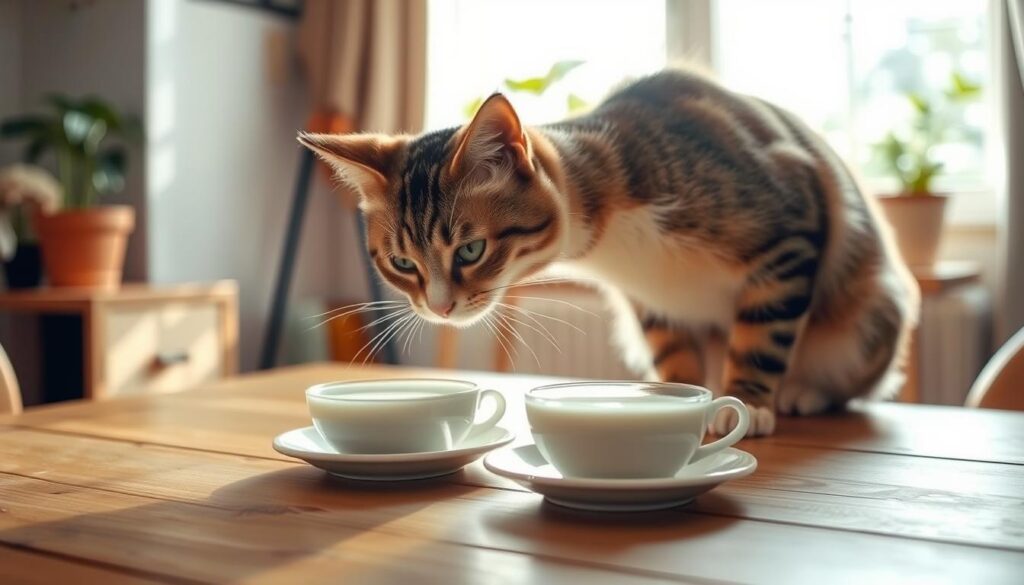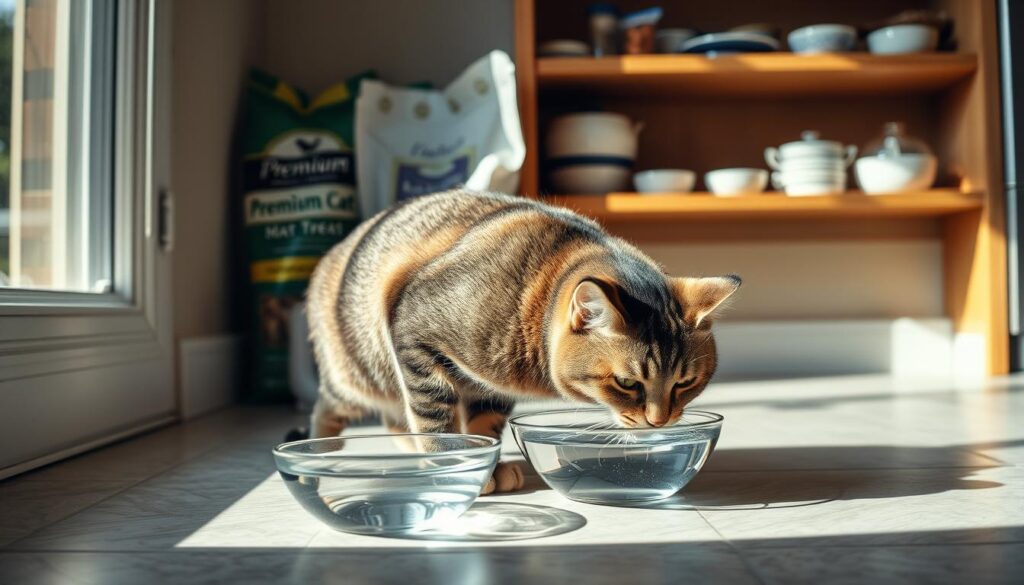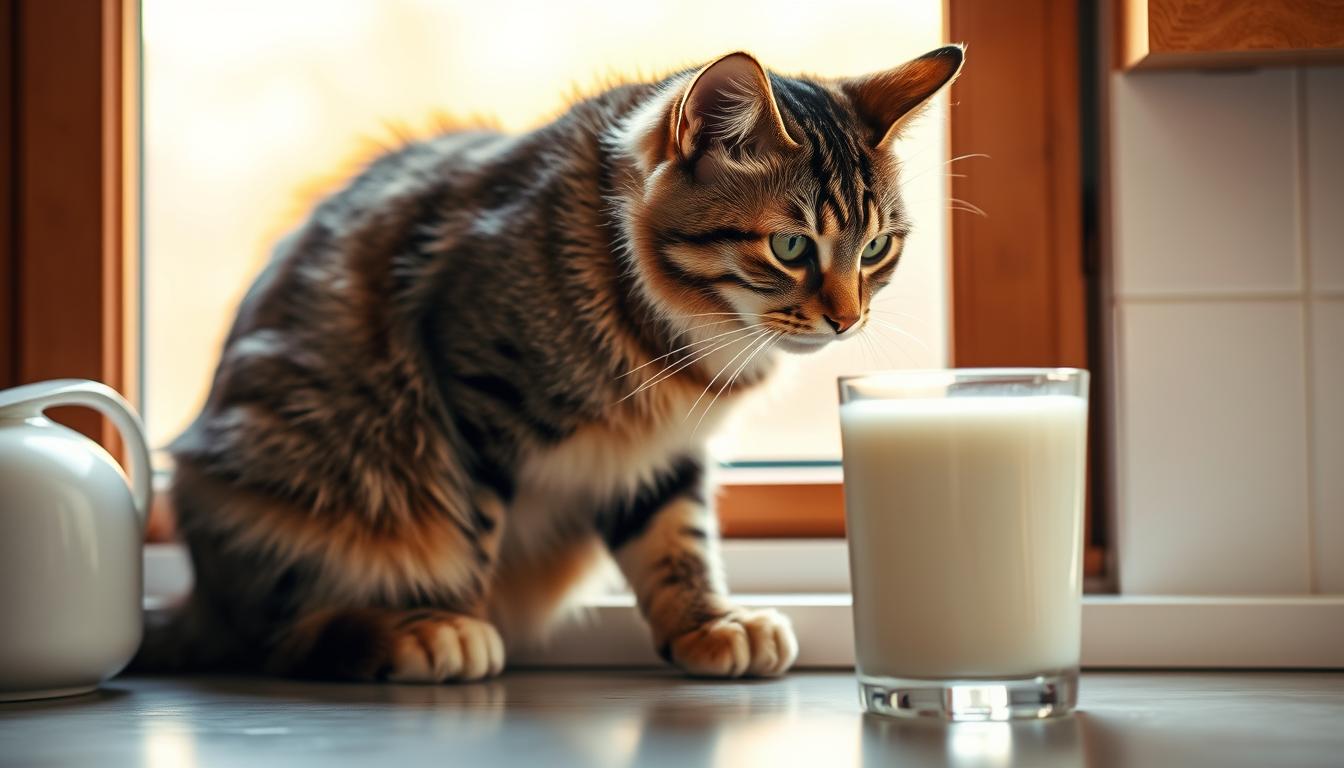can cats have milk: Cartoons and memes often show cats drinking milk. But, the reality is different. Most adult cats can’t digest lactose well. This is because up to 90% of them don’t have enough lactase, the enzyme needed to break down milk sugars.
Drinking cow’s milk can make your cat very sick. It can cause vomiting, diarrhea, or stomach pain. Veterinarians say milk is not just a harmless treat for cats.
For your cat, drinking cow’s milk often leads to digestive upset. Lactose intolerance is common, not rare. And with 60% of U.S. cats already overweight, milk adds to obesity risks. Even lactose-free options still have calories that count toward your cat’s daily needs.
Key Takeaways
- Most cats are lactose intolerant, causing digestive issues after drinking milk.
- Milk’s high calorie content risks obesity in cats, already a problem for 60% of U.S. felines.
- Even small amounts of milk can overwhelm a cat’s digestive system within hours.
- Lactose-free milk isn’t nutritionally necessary and contributes to daily calorie limits.
- Water remains the safest and most critical fluid for cats to avoid dehydration.
The Popular Misconception About Cats and Milk
For centuries, the idea of cats and milk has been a common image. This belief started when cats were given cow’s milk on farms. It became a symbol of care in stories and art, but science now shows it’s not safe.
Where the Cat-Milk Association Began
Early farmers saw barn cats drinking spilled milk. They thought cats and milk were meant to be together. But, children’s books and cartoons made it seem like cats loved milk, ignoring their natural diet.
What Popular Media Gets Wrong
Shows like Tom and Jerry and Disney’s Pinocchio show cats loving milk. But, cats can’t digest cow’s milk because they lack the enzyme lactase. This myth still exists today.
Why This Myth Persists Today
There are three main reasons:
- Cultural nostalgia: Many believe cats and milk are safe because they grew up with it.
- Media repetition: Ads still use cats with milk to sell products.
- Simplified messaging: “Cats love milk” is easier to remember than the complex truth.
| Myth | Reality |
|---|---|
| Cats crave milk daily | Milk isn’t a natural part of their diet |
| Milk is a nutritional necessity | Cats get hydration from water, not milk |
| All cats enjoy milk equally | Only 20-30% tolerate lactose without issues |
Knowing the history of cats and milk helps us understand why the myth persists. But, science shows most adult cats can’t digest lactose, making cow’s milk risky. Today, there are safer alternatives, but tradition still influences many pet owners.
Understanding Lactose Intolerance in Cats
Lactose intolerance in cats happens as they grow from kittens. Kittens are born with lactase, an enzyme that breaks down lactose in their mother’s milk. But by 6–12 weeks old, this enzyme drops a lot.
Without enough lactase, lactose in the gut ferments. This causes a lot of discomfort.
Symptoms of lactose intolerance in cats include:
- Diarrhea or soft stools
- Bloating and abdominal discomfort
- Excessive gurgling stomach noises
- Frequent trips to the litter box
About 70–95% of adult cats can’t digest dairy sugars well. Symptoms show up 8–12 hours after they drink milk. This leads to sudden discomfort.
| Stage | Lactase Levels | Risk of Intolerance |
|---|---|---|
| Newborn kittens | High | Low |
| Adult cats | Minimal | Very high |
Some cats might have mild reactions, while others face severe digestive issues. If you think your cat has lactose intolerance, see your vet. They can suggest enzyme supplements or special diets to help.
What Happens When Cats Drink Milk?
The image of cats drinking milk is iconic, but the reality is different. Most cats don’t digest milk well because they lack certain enzymes. Here’s what happens after they take that first sip.
“A saucer of milk for a cat equals a 12-inch pizza for a human in calories,” warns the People’s Dispensary for Sick Animals (PDSA). This comparison shows how many calories are in even a small amount.
Immediate Digestive Responses
Cats can’t break down milk’s sugars because they lack lactase enzyme. The undigested lactose goes to the intestines. There, bacteria ferment it, causing gas and acid. This makes the cat feel bloated and uncomfortable right away.
Short-Term Health Effects
- Vomiting or diarrhea often strikes 8–12 hours after consumption.
- Stomach cramps and excessive gas lead to restlessness or lethargy.
- Kittens face higher dehydration risk due to smaller body mass.
Potential Long-Term Consequences
Drinking milk regularly can lead to long-term problems like irritable bowel syndrome and obesity. Cats may stop eating balanced food, causing nutrient deficiencies. Studies show 70–90% of adult cats suffer digestive damage from milk. Annual vet costs for these issues can be over $270, according to pet care studies.
Safe alternatives like CatSip or CatSure offer hydration without lactose. But, always check with your vet before adding any dairy substitutes to your cat’s diet.
Can Cats Have Milk in Some Circumstances?
While most cats should avoid milk, there are a few rare exceptions. Kittens under six weeks can digest their mother’s milk. But cow’s milk isn’t a safe substitute. Adult cats vary—some may handle tiny amounts without upset stomachs. Here’s what to consider before offering any dairy.

| Milk Type | Lactose Content | Risk Level | Recommendation |
|---|---|---|---|
| Cow’s Milk | 4.7% lactose | High | Avoid. Causes diarrhea in 90% of cats. |
| Lactose-Free Milk | 0% lactose | Moderate | Risk of bloating due to fat content. |
| Plant-Based Milks | Varies | High | Carbs in almond/soy milk may cause digestive issues. |
Age matters: Kittens lose lactase enzymes after weaning. Even if your cat seems fine with small amounts, long-term risks remain. Most adult cats can’t digest lactose beyond 6 grams—about 130ml of cow’s milk. Over time, this leads to stomach pain or dehydration.
- Individual tolerance: 10% of cats retain some lactase. Test with 5ml of lactose-free milk. Watch for vomiting or soft stools.
- Small portions: Even “tolerant” cats face risks. A teaspoon of milk equals 0.3 grams lactose. Exceeding this daily adds up.
“No milk type is safe for all cats. Always prioritize water.” – American Veterinary Medical Association
When in doubt, consult your vet. Kittens need specialized formula, not household milk. Even if your cat seems to handle milk, the risks of obesity and nutrient gaps outweigh the treat’s appeal. Always keep fresh water available—it’s their safest hydration source.
Safer Milk Alternatives for Your Feline Friend
Regular milk isn’t safe for most cats. Milk substitutes for cats are a safer choice. Brands like WHISKAS Catmilk, CatSip, and KMR have less lactose, making them easier to digest. They also add nutrients like taurine, which is good for your cat’s health.
- Commercial cat milk: Brands like CatSip mimic milk’s texture but remove harmful lactose, making them a safe occasional treat.
- Plain yogurt: Small amounts of unsweetened, unflavored yogurt contain probiotics that aid digestion, but avoid types with added sugars.
- Goat’s milk: Lower in lactose than cow’s milk, but still serve sparingly to avoid upset stomachs.
Plant-based options like almond or oat milk aren’t ideal. They often contain xylitol or high carbohydrates, which cats can’t process. Cats need high protein, and these milks often lack it. Always check labels for harmful additives.
When introducing milk substitutes for cats, start with a tiny amount. Watch for signs of discomfort like vomiting or diarrhea. Always pair these treats with a balanced diet rich in protein. Consult your vet before trying new options, especially for kittens or cats with health issues.
Remember: hydration is key. Wet food and fresh water should remain your cat’s main hydration sources. Treats like these substitutes are occasional indulgences, not dietary staples.
Proper Hydration for Cats: What They Really Need
Water is key for cat nutrition and health. A 10-pound cat needs about one cup of water every day. They also get moisture from their food.
Wet food, with up to 80% water, helps keep your cat hydrated. It’s better than milk, which can be risky for cats.

- Place multiple water bowls around your home in quiet, accessible spots.
- Choose metal or ceramic bowls—cats often avoid plastic due to odors.
- Use a flowing water fountain; cats prefer moving water sources.
- Refresh water twice daily to maintain freshness and cleanliness.
Cats on dry food diets need more water bowls. Kibble has only 10% moisture. Watch for signs of dehydration like dry gums, lethargy, or sunken eyes.
The skin tent test can show dehydration. If it’s severe, a vet might give IV fluids.
Make hydration a part of your cat’s routine. Mix wet and dry food. Adjust their diet with the seasons.
In hot weather, add moisture-rich meals like “Meat in Sauce” varieties. This boosts their water intake. Proper hydration keeps your cat’s cat nutrition balanced and supports their health.
Essential Cat Nutrition: Beyond the Milk Question
When we talk about cat nutrition, milk is just the tip of the iceberg. Cats need a diet that matches their natural diet as meat-eaters. Let’s explore what really keeps them healthy.
Protein Requirements for Cats
Cats need lots of animal protein for growth and energy. Choose foods where meat or fish is the main ingredient. Amino acids like taurine, found in meat, are key for heart and eye health. Don’t make plant-based proteins the main part of their diet.
The Role of Fats in Feline Diets
Healthy fats give cats energy and help their skin and coat. Look for foods with omega-3 and omega-6 fatty acids. Sources like salmon or flaxseed oil are better for their joints and brain than dairy fats.
Vitamins and Minerals Your Cat Needs
Cats need the right vitamins (A, B12) and minerals (calcium, phosphorus) for strong immunity and bones. Commercial cat foods have these. But milk doesn’t have them and can upset their balance.
Remember: cat nutrition is about everyday food, not just treats. Stick to meat-based diets and talk to your vet about your cat’s specific needs. Ignore myths and choose science-backed options for your cat’s health.
Special Considerations for Kittens and Senior Cats
Kittens and senior cats need special care with dairy for cats. Kittens start with their mom’s milk, which is full of important nutrients. But cow’s milk can upset their stomachs, causing diarrhea and dehydration.
For kittens without a mom, special milk replacers are a must. These formulas are made to match feline milk. They help kittens grow without the problems of lactose.
- Newborns (0–1 week): 6–8 feedings daily
- 2–3 weeks: 4–6 feedings
- 3–4 weeks: Start weaning with soft foods
| Age | Feeding Frequency |
|---|---|
| 0–1 week | Every 2–3 hours |
| 2–3 weeks | Every 4 hours |
| 4+ weeks | Transition to solid food |
Senior cats should avoid dairy for cats because their digestive systems get weaker with age. Even a little bit can make them vomit or have diarrhea. Always talk to a vet before giving them dairy products.
Senior cats do best on diets high in protein, tailored to their age. Watch kittens grow—10–15 grams daily after birth is key. If a kitten seems tired or cold, get help right away.
Remember: Kittens should be weaned by 8 weeks. Senior cats need lactose-free options. Always think about their special needs to keep them healthy.
Other Dairy Products and Their Effects on Cats
While milk gets most of the attention, other dairy for cats like yogurt, cheese, and ice cream also need careful consideration. Many owners wonder if these alternatives are safer. But each has unique risks and benefits.
- Yogurt and Fermented Dairy: Plain yogurt with live cultures may have less lactose. This is because bacteria break it down. Small amounts could be tolerated by some cats, but always check for added sugars.
- Cheese and Cats: Hard cheeses like cheddar or parmesan have lower lactose but high fat and salt. Too much can cause stomach upset or weight gain.
- Ice Cream and Sweetened Products: These combine lactose with sugar and additives. The high sugar content poses risks for diabetes and obesity.
Even lactose-free milk or “cat milk” should be used sparingly. These products lack lactose but still add extra calories. Always prioritize your cat’s regular diet over dairy treats.
Watch for signs like vomiting or diarrhea within 8–12 hours after any dairy intake. If your cat shows discomfort, contact your veterinarian immediately. Remember, kittens need their mother’s milk, not cow-based products.
What to Do If Your Cat Consumes Milk
If your cat accidentally drinks milk, it’s important to know how to react. Lactose intolerance is common in cats, affecting up to 90% of adult cats. Knowing the symptoms and when to seek help can help avoid serious issues.
Recognizing Signs of Digestive Distress
Cats with lactose intolerance may show signs like vomiting, diarrhea, or loss of appetite soon after drinking milk. Look out for:
- Soft stools or loose bowel movements
- Abdominal bloating or discomfort
- Excessive drooling or lethargy
Home Care Measures
If symptoms are mild, follow these steps:
- Withhold food for 12 hours to let their system rest.
- Offer small amounts of water frequently to prevent dehydration.
- After 12 hours, reintroduce bland foods like plain chicken or a vet-approved diet.
Most cats recover within 24 hours. Avoid giving more dairy products.
When to Consult Your Veterinarian
Seek immediate care if your cat shows:>
- Vomiting持续超过24 hours
- Inability to keep fluids down
- Signs of dehydration (dry gums, sunken eyes)
- Unresponsiveness or severe pain
Severe cases may need IV fluids or medical treatment. Always contact a vet if symptoms worsen or last more than 24 hours.
Conclusion: Prioritizing Your Cat’s Digestive Health
Your cat’s digestive health is all about the right cat nutrition, not myths about milk. Most adult cats can’t digest lactose well because they lose this ability after weaning. This means 70-90% of cats are lactose intolerant.
If you’re thinking about goat milk, start with just a little—about 1 teaspoon a day. Keep an eye out for any signs of trouble like vomiting or diarrhea. Wet food is a better choice because it keeps your cat hydrated and gives them nutrients without the risks.
Good cat nutrition means choosing foods high in protein and clean water over treats. Always check with your vet before adding dairy to your cat’s diet. Choosing vet-approved food ensures your cat gets the vitamins they need and avoids digestive problems. Making smart choices now helps your cat stay healthy for years to come.
FAQ
Can cats have milk at all?
Why do we associate cats with milk?
What happens to cats that drink milk?
Are some cats able to drink milk without problems?
What are the best alternatives to regular milk for cats?
How should I keep my cat hydrated if not with milk?
What nutritional needs should I focus on for my cat?
What should I feed kittens in place of cow’s milk?
Are there any dairy products that are better for cats than milk?
What should I do if my cat drinks milk and shows signs of distress?
Source Links
- Is Milk Bad for Cats? | Litter-Robot – https://www.litter-robot.com/blog/is-milk-bad-for-cats/?srsltid=AfmBOoqTERdrTj6je12gjskSrJd0CQlWCvR0KkpnDMz8Alz7Ux4Lu8Bt
- Can Cats Drink Milk? The Truth Your Vet Wants You to Know – https://supertails.com/blogs/posts/can-cats-drink-milk-the-truth-your-vet-wants-you-to-know?srsltid=AfmBOoqkzSDpyo3kQAx9k5Ie-b63eQCZFXel1vzj5Q67SRveYJ26M1lp
- Is Milk Good for Cats? Debunking Popular Cat Food Myths – https://cats-magazine.com/education/is-milk-good-for-cats-and-other-myths-you-shouldnt-believe/
- Why Cats and Cow’s Milk Don’t Mix – https://www.4pawsanimal.com/services/cats/blog/why-cats-and-cows-milk-dont-mix
- Are Cats Lactose Intolerant? – https://www.everhartvet.com/are-cats-lactose-intolerant/
- Are Cats Lactose Intolerant | Symptoms & Alternatives – https://felinefancy.co.uk/blogs/cat-care-tips/are-cats-lactose-intolerant?srsltid=AfmBOopKnDo-XCtqr74ihAo67XM4JU9lhNTZou5KyZyoWvaH8c7EGZIs
- Is Milk Actually Healthy for Cats to Drink? – https://www.thesprucepets.com/can-cats-have-milk-552036
- Can Cats Drink Milk? – https://be.chewy.com/nutrition-pet-diet-tips-can-cats-drink-milk/
- Can Cats Drink Milk? – https://wagwalking.com/wellness/can-cats-drink-milk
- Can Cats Drink Milk? – https://noblevetclinic.com/blog/can-cats-drink-milk
- Can Cats Have Milk: Treat or Trouble? – The Pet Staff – https://thepetstaff.com/cats/diet/can-cats-have-milk/
- Can cats drink milk? – https://www.animalfriends.co.uk/cat/cat-advice/cat-food-and-diet/can-cats-drink-milk/
- Can Cats Drink Milk? No! Try These Feline Friendly Milk Substitutes – https://www.holistapet.com/blogs/cat-nutrition/can-felines-drink-milk?srsltid=AfmBOor08Qlg-hB9NTBanPeiHQca7Yex87QstaK8QKiw2329-dux9LXd
- Can Cats Drink Plant Milk? Exploring Non-Dairy Options | Cat Boarding Hotel Laguna, Mission Viejo, Anaheim, Santa Ana, CA | Cats Luv Us – https://www.catsluvus.com/cat-grooming/can-cats-drink-plant-milk-exploring-non-dairy-options/?srsltid=AfmBOorCHXnveT5HQkuxLw_cjZtB6LJwPnaBmZESTvfcFyz52yggZqq5
- What should cats really be drinking? Our vet shares her recommendations and what to avoid at all costs – https://www.aol.com/cats-really-drinking-vet-shares-120000713.html
- Cat Dehydration: Symptoms, Causes, and Treatments – https://www.webmd.com/pets/cats/dehydration-cats
- How much fluid does a cat need? – Happy Cat – https://happycat-petfood.com/cat-advisor/cat-nutrition/fluid-requirement
- Can Cats Drink Milk? The Truth Your Vet Wants You to Know – https://supertails.com/blogs/posts/can-cats-drink-milk-the-truth-your-vet-wants-you-to-know?srsltid=AfmBOookJOPDMFV4UFGrWBZsHgPUZjla7OlSI2bJaqcb-2JEGIfJt-xh
- Can Cats Drink Milk? Vet Approved Nutrition Facts & FAQ – Catster – https://www.catster.com/nutrition/can-cats-drink-milk/
- Can Cats Drink Milk? No! Try These Feline Friendly Milk Substitutes – https://www.holistapet.com/blogs/cat-nutrition/can-felines-drink-milk?srsltid=AfmBOor2pMwKmAYPYTHHYRYirOzL2mmrl45zilvDs6TR9u1AO7747Jiu
- Bringing up a litter of kittens: health considerations – https://icatcare.org/articles/bringing-up-a-litter-of-kittens-health-considerations
- Everything You Need to Know About Bottle Feeding a Kitten – https://www.petmd.com/cat/general-health/bottle-feeding-a-kitten
- Are cats lactose intolerant? | Blog – https://www.cats.org.uk/cats-blog/are-cats-lactose-intolerant
- Why Do Cats Like Milk? 2 Vet-Approved Reasons & FAQ – Catster – https://www.catster.com/nutrition/why-do-cats-like-milk/
- Is Milk Bad for Cats? | Litter-Robot – https://www.litter-robot.com/blog/is-milk-bad-for-cats/?srsltid=AfmBOoowqkHa-t2vwzDqSnkKwu5SA-ad20YE8DIGa5u2WJLhrsrrSIm5
- Addressing Lactose Intolerance in Felines – Presqu’ile Animal Hospital – https://presquileanimalhospital.com/lactose-intolerance-in-felines/
- Comparing Organic Goat Milk and Other Dairy Alternatives for Cats – https://www.bjsrawpetfood.com/blogs/all/comparing-organic-goat-milk-and-other-dairy-alternatives-for-cats?srsltid=AfmBOoppOJ7V89YB_zLHV-dMa35xLP9X3W5h1SgXwW76upjHn-KZcIUG
- Can Cats Drink Milk? The Truth Your Vet Wants You to Know – https://supertails.com/blogs/posts/can-cats-drink-milk-the-truth-your-vet-wants-you-to-know?srsltid=AfmBOoruHIAlT1MPmdmBJck8hR4ZOVAXI7NethdiAnnjJkWYaMyrGzDT
